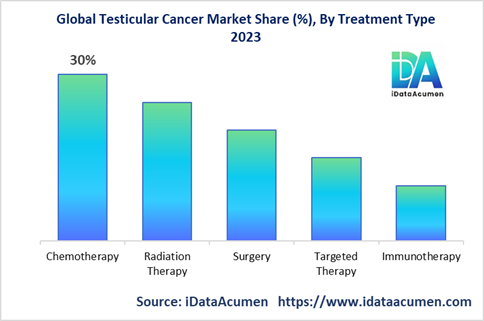Global Testicular Cancer Market is expected to reach US$ 1,083.3 million in 2031 with a growth rate of 5.8%. The testicular cancer drugs market consists of pharmaceutical therapies and medical devices used for treating testicular cancer. Testicular cancer is a rare cancer that affects the testicles, occurring mostly in men aged 15-40 years.
The rising prevalence of testicular cancer globally is a key driver fueling the growth of the testicular cancer market. According to the American Cancer Society, cases of testicular cancer have been steadily rising over the past 40 years, especially among Caucasian men. Other market drivers include the strong pipeline of novel therapies, high investments in R&D, and favorable reimbursement policies.
Testicular cancer is a disease that affects the testicles, which are part of the male reproductive system. It occurs when abnormal cells in the testicles begin to multiply uncontrollably, forming a tumor.
Key Report Insights:
- Major market driver: Rising prevalence of testicular cancer globally, with incidence rates increasing 1-6% per year in many countries
- Companies are focused on developing novel therapies, combination regimens, and advanced radiation therapies to improve treatment outcomes for testicular cancer patients. Several immunotherapy drugs are in clinical trials.
- Advancements in diagnostic imaging and blood tumor markers like AFP, beta-HCG, and LDH have improved early detection and prognosis of testicular cancer.
Emerging trends like personalized medicine and pharmacogenomics have potential to advance testicular cancer treatment by identifying best drug responses based on patient genetic profile.
Key players are actively focused on developing targeted therapies and immunotherapies to improve treatment outcomes for patients. For instance, the PD-1 inhibitor pembrolizumab was recently approved as a first-line therapy for advanced testicular cancer. Such product approvals are creating significant growth opportunities. Furthermore, increasing strategic partnerships between pharmaceutical companies are enabling drug innovation and pipeline expansion.
The testicular cancer market is segmented based on treatment type, tumor type, end-user, drug class, and region. The treatment type segment is dominated by chemotherapy drugs like cisplatin, etoposide, and bleomycin. Targeted therapies and immunotherapies are expected to gain traction during the forecast period. By end-user, hospital pharmacies accounted for the largest share, while specialty clinics are expanding at a significant pace.
North America was the largest regional market, accounting for over 40% of global revenues in 2022. High incidence rates in the U.S. coupled with high diagnosis rates and favorable reimbursement drive the North American market growth. Europe accounted for the second largest share of the global testicular cancer market.
Key players operating in the testicular cancer market include Pfizer, Bristol-Myers Squibb, Merck & Co., Roche, Novartis, Johnson & Johnson, AbbVie, Astellas Pharma, Seattle Genetics, Agensys, and others. These players are focused on new product development and expanding their product portfolio through approvals in newer indications.

Market Drivers:
- Increasing investments in R&D for novel therapies and strategic partnerships between pharmaceutical companies are supporting drug innovation for testicular cancer treatment. Recently, Genmab partnered with Janssen Biotech in a deal worth USD 1 billion to develop cancer drugs, including for testicular cancer.
- Favorable reimbursement policies and insurance coverage improve patient access to testicular cancer drugs, driving market growth. Platinum chemotherapy agents commonly used as first-line therapy have widespread coverage globally.
Trends:
- A major trend is the emergence of targeted therapies and immunotherapies like PD-1/PD-L1 inhibitors for testicular cancer treatment. Several checkpoint inhibitors are currently in late-stage clinical trials.
- The integration of pharmacogenomics and genomic biomarker testing is enabling personalized medicine approaches for testicular cancer.
Opportunity:
Strategic partnerships between pharmaceutical and diagnostic companies to develop companion diagnostics for novel therapies present significant opportunities for market growth.
Key Regional Insights:
- North America accounted for the largest share of over 40% in 2024 due to high incidence in the U.S., favorable reimbursement, and strong presence of major players like Pfizer, Merck, and Bristol-Myers Squibb. Rising prevalence of testicular cancer in North America is a key regional driver.
- Europe accounted for the second largest market share of around 30% in 2024, driven by increasing incidence and access to newer targeted drugs. Key players in Europe include Roche, Novartis, and Johnson & Johnson.
- Leading companies operating in the global testicular cancer market include Pfizer, Bristol-Myers Squibb, Merck & Co, Roche, Novartis, Johnson & Johnson, and Astellas Pharma, among others. These players have a strong focus on R&D and product development.
Testicular Cancer Market Segmentation:
- By Treatment Type
- Chemotherapy
- Radiation Therapy
- Surgery
- Targeted Therapy
- Immunotherapy
- By Tumor Type
- Seminoma
- Non-seminoma
- Mixed Germ Cell Tumor
- Teratoma
- Yolk Sac Tumor
- Choriocarcinoma
- Others
- By End-User
- Hospitals
- Cancer Research Institutes
- Multispecialty Clinics
- Ambulatory Surgical Centers
- Others
- By Drug Class
- Alkylating Agents
- Antimetabolites
- Other Cytotoxic Agents
- Targeted Therapies
- Immunotherapies
- By Route of Administration
- Oral
- Intravenous
- Intramuscular
- Subcutaneous
- Others
- By Regions
- North America
- Europe
- Asia Pacific
- Latin America
- Middle East & Africa
Definition:
“The testicular cancer market refers to the pharmaceutical drugs, therapies, and medical devices used for the treatment of testicular cancer. Testicular cancer is a disease in which malignant cells form in the tissues of one or both testicles. It is a rare cancer that most commonly affects men between ages 15-40. The testicular cancer market consists of companies developing and commercializing chemotherapy, radiation therapy, immunotherapy, and targeted drug options for testicular cancer patients. Key segments include hospital pharmacies, retail pharmacies, clinics, research institutes, and online sales channels. The testicular cancer market is poised for steady growth due to rising prevalence, disease awareness efforts, and pharmaceutical innovation."